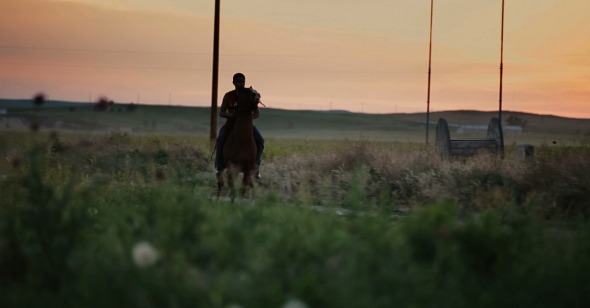One World
By Caitlin Quinlan
Spaces of Exception
Dir. Matt Peterson and Malek Rasamny, U.S., self-distributed
Playing at New York’s Anthology Film Archives October 27–30.
It is a terrible thought to have while watching a film, but given recent circumstances, I couldn’t help wondering how many of the people featured in Matt Peterson and Malek Rasamny’s Spaces of Exception are still alive. Shot between 2014 and 2017, the documentary observes life in four Palestinian refugee camps in the West Bank and Lebanon and in several Indigenous American reservations across the United States, drawing parallels between the spaces and the oppression of the people within them. There are distinct circumstances and histories to both the refugee camp and the reservation, but they are united, tragically, by the ongoing threat of genocide at the hands of a colonial power. The people interviewed by the filmmakers tell stories of massacre and loss; soon, the film is not a portrait of how they live, but, as it soon becomes clear, how they will likely die.
Peterson and Rasamny’s approach is one of juxtaposition, structuring the film as a series of alternating stories that provide more comparison than contrast. They begin in the Pine Ridge Indian Reservation of the Oglala Lakota people, where kids ride horses past dilapidated buildings while flooded earth keeps the playground out of use; notably, there is hardly any archival footage throughout the film, positioning these issues, necessarily so, as contemporary and urgent. It’s a poignant entry point for the film, not only because Pine Ridge is one of the largest and poorest reservations in the United States but also because of its history as the site of several major events in Indigenous American history, most notably the Wounded Knee Massacre of 1890. One interviewee describes the reservation as a “concentration camp,” where the Lakota people have been stripped of their rights and agency for several decades. Their language, equally, is something they mourn; without this integral element of their culture, of their resistance against the American government, they are significantly weakened.
At the largest refugee camp in the West Bank, Balata, around 30,000 Palestinian refugees live in 0.25 sq km of space originally intended to house only 5,000 people. The camera lingers on the narrow corridors between buildings, without the space to look up or around. Everything here is about containment; people are trapped in an environment where new homes can only be built upwards, further blocking out the sky, and their hopes of freedom are cut down by the occupying forces who withhold money and regularly imprison inhabitants with little reason. The very existence of Balata and of all Palestinian refugee camps is the result of immense trauma—the permanent displacement of Palestinians following the war of 1948. The history of the land here, like at Pine Ridge, is inextricable from the suffering of its people, and Peterson and Rasamny’s film draws these connections clearly. Rather than taking an expansive, academic approach, the filmmakers opt for an intimate view of these environments and center personal testimonies and the lived experience of the interviewees. Each segmented portrait of a location offers an open and exposing view of the pain that exists there and the helplessness of those who long for change.
This separation of the spaces chosen in the film into discrete, longer chapters, rather than a structure where they are frequently interchanged, grants them individuality and acknowledges their important distinctions while still exploring their inherent similarity. This only strengthens the solidarity the film encourages—to support the resistance of oppressed people in one location is to support oppressed people everywhere. And while there is a central focus on the persecution of the Palestinians and Indigenous Americans, there is a commitment to sharing their hopes and visions for the future, too. Every interview is a vocal expression of defiance; “the mere fact of my breathing in the heart of the camp is a war, a war of existence,” says one Palestinian woman. Towards the end of the film, when the members of a family from the Navajo Nation sit down for a meal and speak Navajo to one another, the filmmakers forego subtitles as a respectful gesture towards the sovereignty of their language.
Spaces of Exception is, in formal terms, uncomplicated—there is no need for stylistic or narrative gimmicks in instances of such tyranny—but as a document of these places and people over the last decade, it is a profound act of visibility in the face of systemic erasure. It is also very difficult to watch from a position of further contemporaneity, years on from when it was filmed. But, as is clear in the film, resistance remains; “We are, thank God, like the mountains,” says an older man from the Balata camp. “Never shook by the wind.”
